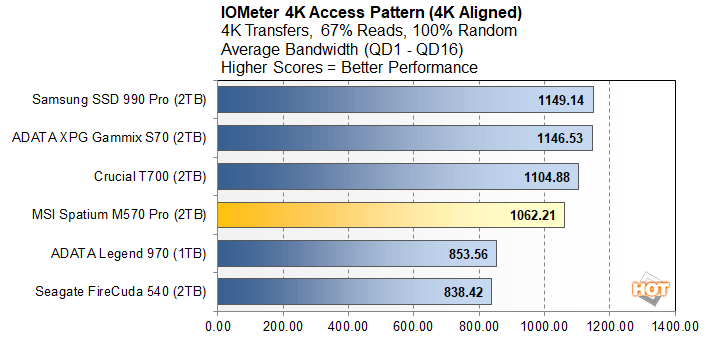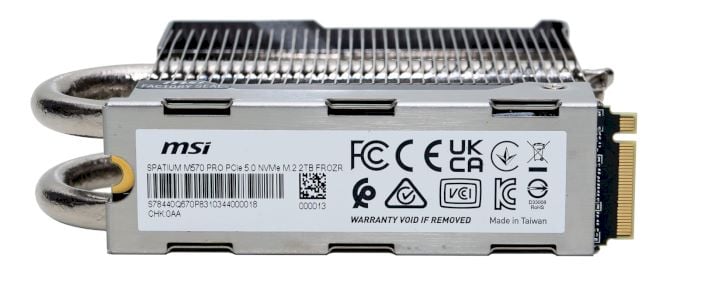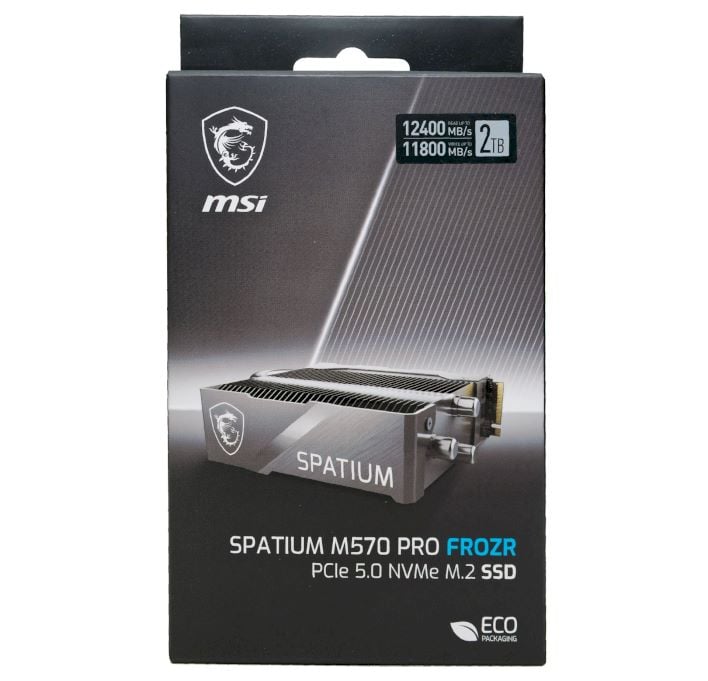MSI Spatium M570 Pro SSD Review: Big Cooler, Super Performance
MSI Spatium M570 Pro SSD Review: A Speed Demon, With Massive Cooling
| MSI Spatium M570 Pro: 2TB for $329 The MSI Spatium M570 Pro is a PCIe Gen 5 SSD with class-leading performance and an integrated cooler that (literally) towers over the competition.
|
|||

|

|
||
You’ve got to see this thing. Let’s get some high-level specs out of the way first, take a tour of the MSI Spatium M570 Pro, and then see how this puppy performs. Spoiler alert: this SSD is fast...
MSI Spatium M570 Pro SSD Specifications And Features

Find The MSI Spatium M570 Pro SSD PCIe 5 SSD @ Amazon
As mentioned, the MSI Spatium M570 Pro is built around a PCIe Gen 5 Phison E26 controller, paired to Micron 232-layer NAND flash memory, and some LPDDR4 DRAM Cache (with capacities ranging from 2GB to 8GB, depending on the size of the drive).
MSI’s specifications claim peak reads and writes for the 2TB (and 4TB) Spatium M570 Pro of 12.4GB/s and 11.8GB/s, respectively, which puts the drive among the current PC storage elite. Faster drives are coming (we previewed one already), but as of this moment, the MSI Spatium M570 Pro can hang with the best of them. And like other premiums SSDs available today, MSI offers a 5 year warranty and supports all of the advance features you’d expect, like TRIM, encryption, etc.
Underneath all that metal is a common M.2 2280 gumstick. But considering these high-end Phison / Micron-based drives can consume more than 11 watts under load, MSI decided to ensure thermals, and the potential throttling that can come as a result of excess heat, would not be problem with the Spatium M570 Pro – hence the massive, tower-type cooler.
As you can see, there’s a tall nickel-plated aluminum fin-stack on the Spatium M570 Pro, linked to a heat-plate by three heat-pipes, that rests directly atop the Phison E26 controller, top-side NAND and DRAM cache. While all high-end E26-based drives require some sort of cooling, few go as hard as MSI did here. Provided there is adequate air-flow in your chassis, that large cooler is more than up to the task of keeping the Spatium M570 Pro humming along at top speed.
There are a few downsides to that cooler, however. Without adequate clearance around the M.2 slot, it simply may not fit on some motherboards. It also requires the complete removal of any stylized M.2 heat plates included with most enthusiast motherboards available today. The cooler obviously adds some cost as well, and precludes it from fitting in the PS5.
MSI Spatium M570 Pro SSD SSD Benchmarks
Under each test condition, the SSDs showcased here were installed as secondary volumes in our testbed, with a separate drive used for the OS and benchmark installations. Our testbed's motherboard was updated with the latest BIOS available at the time of publication and Windows 11 was fully updated. Windows Firewall, automatic updates, and screen savers were all disabled before testing, and Focus Assist was enabled to prevent any interruptions.
In all test runs, we rebooted the system, ensured all temp and prefetch data was purged, and waited several minutes for drive activity to settle and for the system to reach an idle state before invoking a test. All of the drives here have also been updated to their latest firmware as of press time. Where applicable, we would also typically use any proprietary NVMe drivers available from a given manufacturer. When not available, the drives used the Microsoft driver included with Windows 11.HotHardware's Test System:
| Processor: Intel Core i9-13900K Motherboard: MSI Z790 Godlike Video Card: GeForce RTX 3080 Memory: 32GB Micron DDR5-6000 Storage: ADATA XPG GAMMIX S70 Blade (OS Drive) ADATA XPG GAMMIX S70 (2TB) Seagate FireCuda 540 (2TB) ADATA Legend 970 (1TB) Samsung SSD 990 Pro (2TB) Crucial T700 (2TB) MSI Spatium M570 Pro (2TB) |
OS: Windows 11 Pro x64 Chipset Drivers: Intel v10.1.19284 Benchmarks: IOMeter 1.1 HD Tune v5.75 ATTO v4.01.01f AS SSD SiSoftware SANDRA CrystalDiskMark v8.0.4c x64 Final Fantasy XIV: Endwalker PCMark 10 Storage Bench 3DMark Storage Tests |
IOMeter Benchmarks
IOMeter is a well-respected industry standard benchmark. However, despite our results with IOMeter scaling as expected, it is debatable as to whether or not certain access patterns actually provide a valid example of real-world performance. The access patterns we tested may not reflect your particular workloads, for example. That said, we do think IOMeter is a reliable gauge for relative throughput, latency, and bandwidth with a given storage solution. In addition, there are certain highly-strenuous workloads you can place on a drive with IOMeter that you can't with most other storage benchmark tools. In the following tables, we're showing two sets of access patterns; a custom Workstation pattern, with an 8K transfer size, consisting of 80% reads (20% writes) and 80% random (20% sequential) access and a 4K access pattern with a 4K transfer size, comprised of 67% reads (33% writes) and 100% random access. Queue depths from 1 to 16 were tested...






In terms of latency, we see more of the same, with the MSI Spatium M570 Pro SSD finishing right on top of the Crucial T700. Note, however, while there are obvious differences in performance between the drives with these workloads, all of these SSDs are fast.
SiSoft SANDRA 2022

ATTO Disk Benchmark
ATTO is another "quick and dirty" type of disk benchmark that measures transfer speeds across a specific volume length. It measures raw transfer rates for both reads and writes and graphs them out in an easily interpreted chart. We chose .5KB through 64MB transfer sizes and a queue depth of 6 over a total max volume length of 256MB. ATTO's workloads are sequential in nature and measure raw bandwidth, rather than I/O response time, access latency, etc.


Once again, in terms of sequential read and write performance, regardless of the transfer size, the MSI Spatium M570 Pro SSD competes well with the Crucial T700, which is to say it is among the fastest drives we've tested to date.


Read and write IO throughput is also very good with the MSI Spatium M570 Pro SSD. It doesn't pull away at any particular point, but it remains in the mix with the fastest drives across the range of transfer sizes.
AS SSD Compression Benchmark
Next up we ran the Compression Benchmark built-into AS SSD, an SSD specific benchmark being developed by Alex Intelligent Software. This test is interesting because it uses a mix of compressible and non-compressible data and outputs both Read and Write throughput of the drive. We only graphed a small fraction of the data (1% compressible, 50% compressible, and 100% compressible), but the trend is representative of the benchmark’s complete results.













